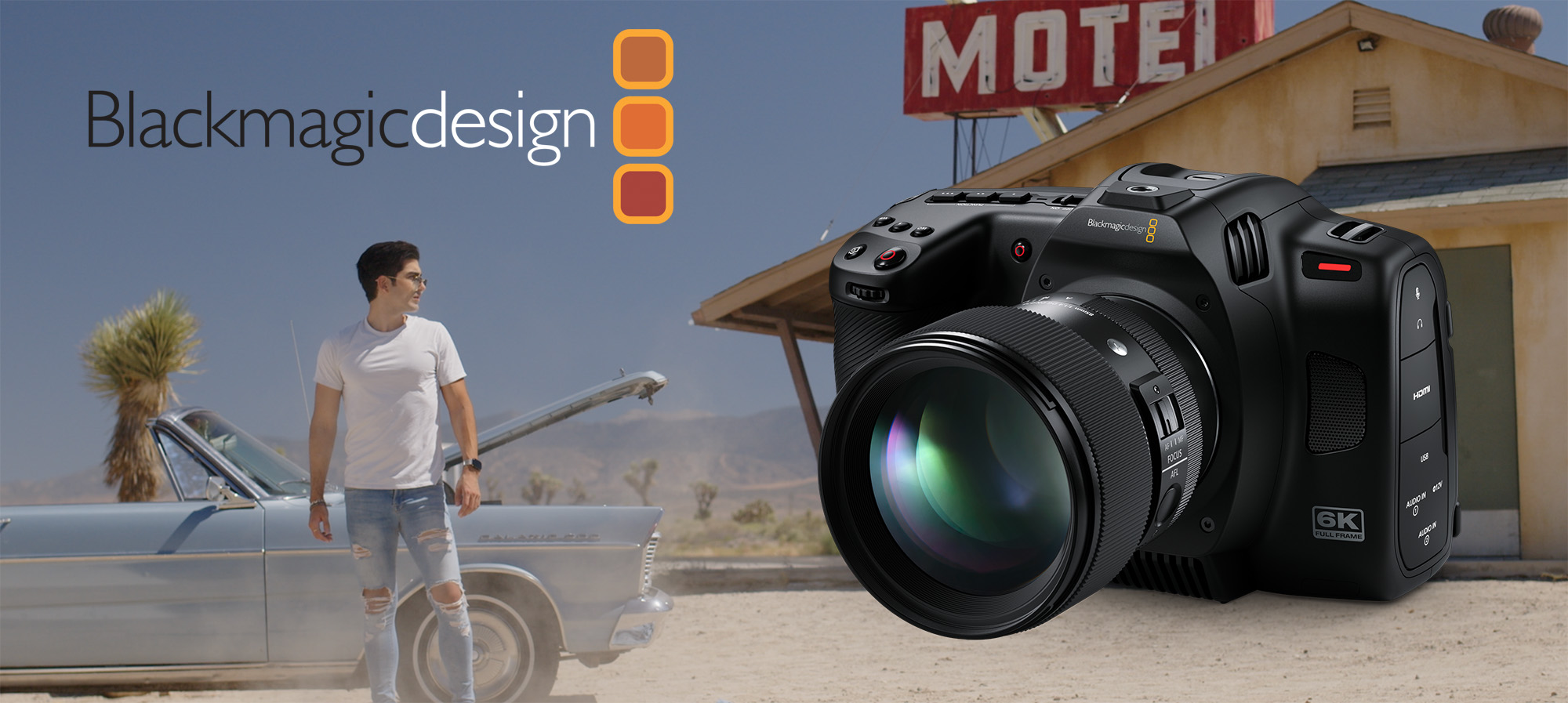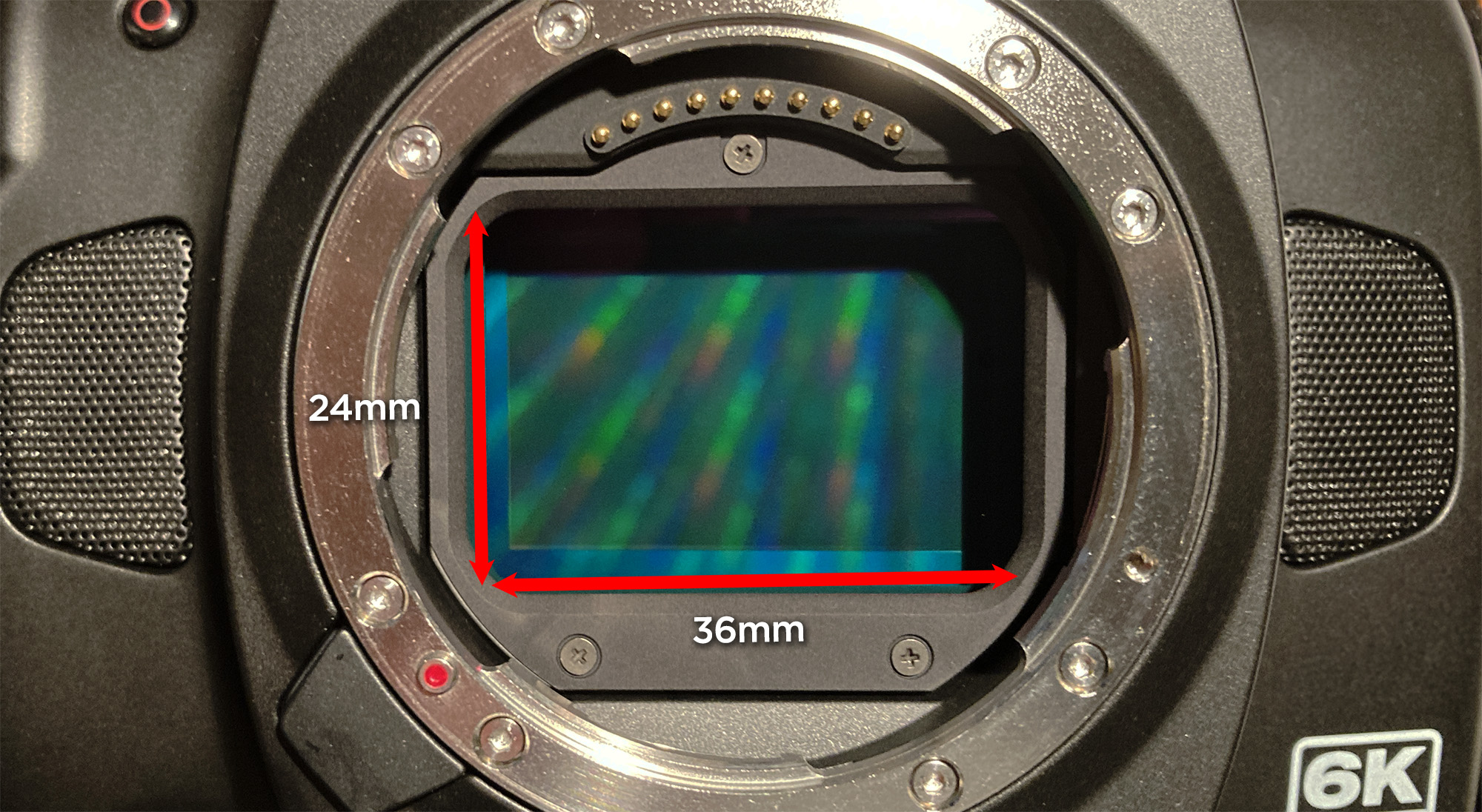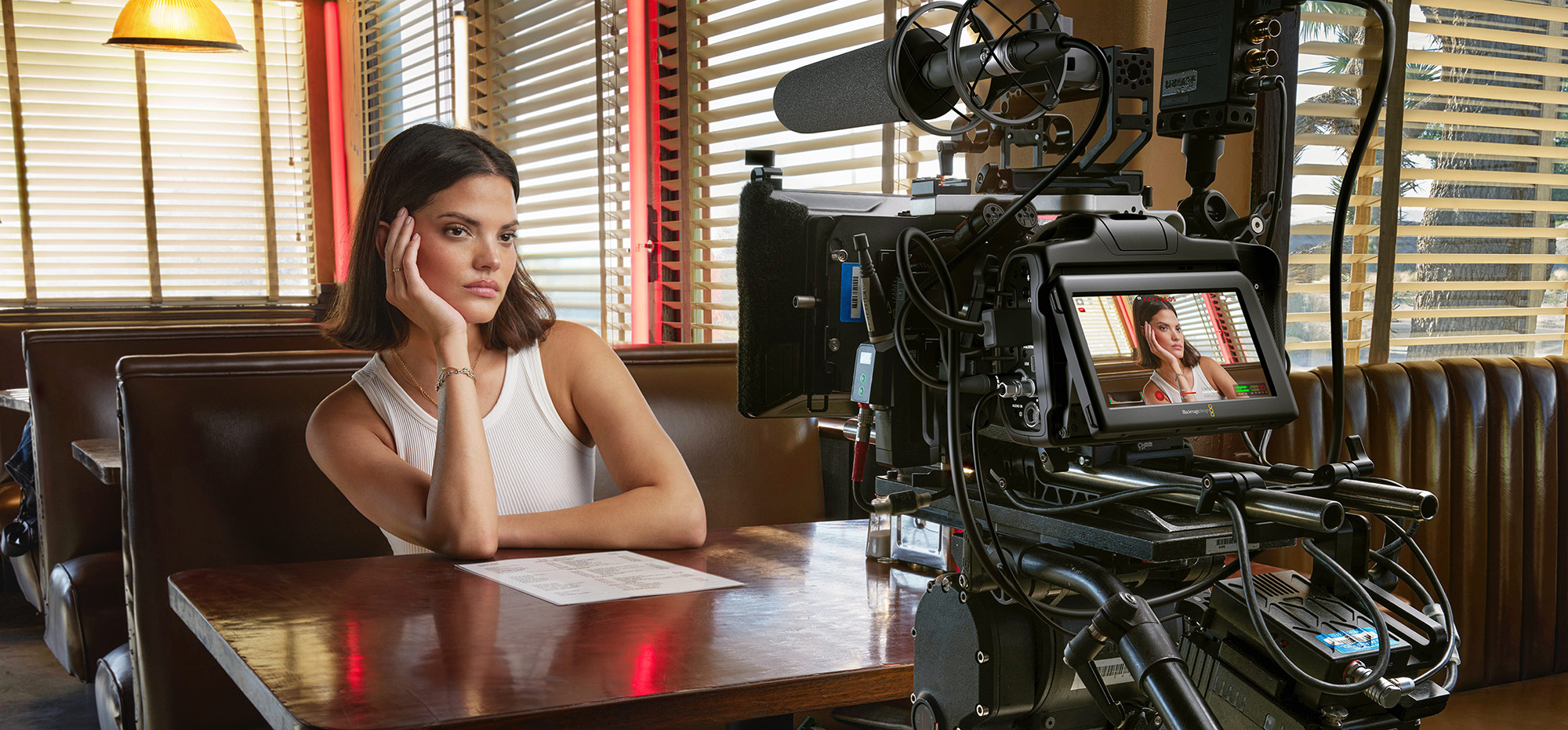
Blackmagic Design has been building cameras for over a decade – many with a DSLR form factor. The latest of these is the Blackmagic Cinema Camera 6K, launched at IBC 2023. This camera is designed as a serious filmmaking tool that offers some similarities to an ARRI Alexa Mini LF or a RED Komodo, but with change to spare. This makes it a good fit for an owner-operator.
The Blackmagic Cinema Camera 6K uses an 36mm x 24mm full frame (FF) sensor with OLPF. That’s equivalent to the size of a 35mm photo frame. The maximum frame size you can record is 6048 x 4032 pixels (3:2 aspect). While cinematic settings like 6K DCI 17:9 and 6K 2.4:1 capture the full 6K width, other options capture a smaller, windowed section of the sensor. For example, if you select 1080 HD, then you get a 1920 x 1080 crop from the larger sensor area. The advantage comes when you want to record with higher frame rates. Shoot 6K Open Gate 3:2 and the maximum frame rate is 36fps. Take a 1080 slice instead and that goes up to 120fps.

This 6K full frame version offers a different feature set than its Pocket Cinema Camera 4K, 6K G2, and 6K Pro cousins. It uses a Leica format lens mount (L-mount) and records Blackmagic RAW files (no ProRes option). The camera body is built with a multi-button grip and features a tilting rear touchscreen LCD viewer with overlays. Optional Blackmagic accessories include a battery power grip and a top-mounting electronic viewfinder (EVF).

The BMCC 6K is comparable in size to a Canon EOS-1D X and is built with a lightweight carbon fiber polycarbonate composite body. However, I wouldn’t consider this a “run & gun” type of camera. It feels solid enough, but it’s not a tank like some of the aforementioned competitors. Plus, with open vents for cooling, you’d want to be careful in inclement weather. Add a zoom lens, batteries, and accessories, and you’ve got a camera that’s at home on a Movi, tripod, dolly, or other support system. Mount it on rails and you’ll want to add a separate external viewfinder, connected via the HDMI port. There’s a built-in stereo mic along with two mini-XLR connectors with optional phantom power for external mics. My purely handheld rig of camera, power grip, and zoom lens weighed in at a manageable five pounds.
Things to know before filming
I’m a video/film editor, so camera reviews aren’t usually my thing. But, I do know my way around cameras. The Blackmagic Cinema Camera 6K and the associated post workflow piqued my interest. Blackmagic Design loaned me the camera, power grip with two additional batteries, and EVF for a couple of weeks. To round out the package, a friend loaned me his Lumix 24-105mm zoom lens (wide angle to short telephoto). The standard retail package includes the camera body, one battery, a 12-volt AC charger, strap, and a license for DaVinci Resolve Studio. A nice touch is that the charger comes with several interchangeable adapter plugs to fit different worldwide electrical outlets.
Each battery is good for about an hour. Attach the power grip for a total of nearly three hours of operation. Or, you can operate on AC power via the charger. The camera records to a CFexpress card (not included) or an external USB-C drive. I opted to use a Samsung T7 SSD formatted as ExFAT. Of course, attaching an external drive would require getting creative with Velcro. Since this was all loaned gear, I just taped the drive to the camera strap and set out for an afternoon of filming.
There are two compression schemes for the Blackmagic RAW codec – constant bitrate (3:1, 5:1, 8:1, 12:1) or constant quality (four levels). Constant bitrate recording yields more predictable file sizes. Constant quality means the bitrate is variable, which allows a higher bitrate (less highly compressed) for more complex images. The uncorrected camera raw file is displayed as a low contrast, log image. A video LUT can be applied to the display, EVF, and any external monitor. This LUT can also be embedded into the file or used separately as a sidecar file (more on that in a minute). A corresponding 1920 x 1080 H.264 MP4 proxy file is also recorded with every Blackmagic RAW file.
A day in the park with the BMCC 6K
I opted to keep things simple and record at a constant bitrate (3:1), filming in the “open gate” resolution (6K, full frame, 3:2 aspect ratio). My clips were filmed off-speed with a project setting of 23.98fps and an off-speed record setting of 30fps. This results in moderate slomo during playback. That’s better for handheld operation when you don’t need sync sound, because it smooths out camera movement. In addition, the Lumix lens includes optical image stabilization, which I used instead of stabilizing in post using camera metadata. The LUT was embedded into these files. Rounding out the picture is a 180-degree shutter angle for proper, filmic motion blur.
DSLR-style video rigs are often unwieldy in handheld situations. However, this is a very nice camera to operate, with numerous functions accessible via buttons and a dial on the grip. These and more are also available on the touchscreen. The optional EVF comes with several eyepiece cups for left and right-eye operation and is activated when you place your eye over it. It’s also got a diopter focus dial if you wear glasses. After a bit of familiarization, it becomes second nature to make adjustments on-the-fly for iris, focus, and color temperature. I quickly appreciated its ergonomics over a cube-style camera body for handheld shooting.
The Blackmagic Cinema Camera 6K uses auto-focus, but it’s not self-adjusting. If your lens supports it, hit the focus button to automatically focus the image at the center of the frame. Reposition the guide in the touchscreen with your finger to focus on something along the edge of the frame. Likewise, there’s a button to adjust iris level, along with a manual iris control dial on the grip.
I was outside filming in shaded and sunny areas. As I moved the camera around, I would reframe or zoom, and then quickly tap the buttons with my thumb to adjust for the changes in light or focal plane. Sometimes the auto-focus will hunt for a second or two until it locks in, so doing this during an active shot isn’t a good idea. At the settings I was using, 30 minutes of content consumed a bit over 500GB of storage space. As expected, 30 minutes of continuous operation drew down the battery charge of a single battery by about 50%. Luckily, the camera didn’t exhibit any heating issues after lengthy recordings on a warm Florida day.
Blackmagic RAW in post
The Blackmagic RAW codec works natively in DaVinci Resolve, as well as with other NLEs using the Blackmagic RAW installer or third-party plug-ins. There have been changes in this codec over time, so install the latest version of Resolve or these plug-ins. The .braw file container carries camera raw video, multiple audio channels, timecode, and an embedded LUT. Long clips are continuous and not spanned like RED camera recordings. The drive or card also uses a simple file/folder structure without the tiered folders created by Sony camera recordings.
There was no need to copy or transcode files from the Samsung T7 drive. I simply plugged the drive into my iMac via USB and was ready to start editing in Resolve or Premiere Pro. The camera does record simultaneous proxy files, but I didn’t really need them. (These also don’t support the embedded LUT and require the sidecar LUT files.) The full quality 6K Blackmagic RAW media played fluidly and I could scrub through the timeline without any stuttering. (Blackmagic’s reps informed me that there’s an upcoming Blackmagic Cloud workflow, as well.)
Because I recorded embedded LUTs, the clips popped up with standard Rec 709 color applied. No need for the sidecar files. That’s helpful for fast turnaround edits. The LUT is not “baked” into the clip, so the camera raw data has been preserved. You can adjust the camera raw settings and grade the shot as needed from the raw data, with or without the LUT. For me, this worked perfectly well in both Resolve and Premiere Pro.
By default these full frame 3:2 aspect ratio clips will be pillarboxed (black bars on the sides) in a 16:9 HD or UHD 4K timeline. Changing the scaling in the inspector to “fill” will match the width of the frame, thus leaving room to move the shot up or down. “Crop” gives you a 1:1 pixel display. Then resize and reposition the shot within the full 6K resolution.
A word about stills
Although it’s not primarily a stills camera, the BMCC 6K does shoot nice 24MP (6K 3:2) stills in the Blackmagic RAW codec (no option for JPEG, TIFF, etc). You can fire off a still while you are recording a motion shot. Or you can change your settings to photography-based nomenclature (such as shutter speed versus shutter angle) and shoot a session of photos.
Unfortunately, the common photo apps like Photoshop don’t support the .braw codec. The workaround is to either stay completely within DaVinci Resolve or use it only as a camera raw processing tool. I simply created a 6K 3:2 timeline with one frame edits and the embedded LUT. Then I batch-exported the sequence as individual clips at native resolution in a TIFF format. This literally took a few minutes and then the stills were ready to bring into any common photo app for further work.
Final thoughts
I’ve only touched on the highlights, but there are many more features. You can shoot with anamorphic lenses, as well as in a vertical mode. There’s a timelapse mode. Work with the built-in LUTs or import your own custom LUTs. There’s a lot of visual information that can be displayed on the viewer and EVF, including guides, false color, focus peaking, and more. You can connect to a network (using a USB-C to ethernet adapter), as well as control the camera wirelessly through Bluetooth with the Blackmagic Camera Control app, as well as other third-party apps, like BlueConnect or Bluetooth+ on an iPhone or iPad. Network connection is useful if you want to transfer files directly from the camera to other storage.
Suffice it to say that the Blackmagic Cinema Camera 6K offers a lot of value with a great-looking, natural image. My total package (camera, lens, accessories, SSD, batteries) would run you at or under $5,000. If anything, with an hour of record time per battery, I’d probably skip the battery power grip and just swap out batteries as needed. The power grip also didn’t feel quite as robust to me as the camera body itself.
What the Blackmagic Cinema Camera 6K does well may not be the perfect fit for some. It’s not an all-in-one camera. But if you compete for high-end work, then its image compares well to the big name cameras, like ARRI, RED, Canon, and Sony. From my point of view as an editor and colorist, I’m happy that the files are as graceful to work with and look good to boot. Pair the camera with the right lenses and you’ve got a winning combination.
Read another opinion on the Blackmagic Cinema Camera 6K here on ProVideo Coalition.

